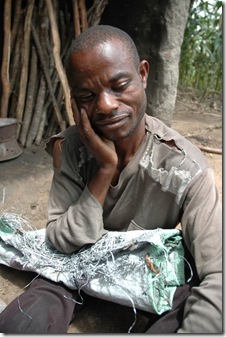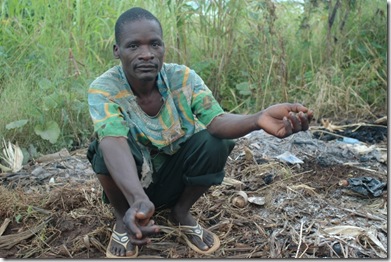
Switzerland-based Corinne Vionnet is our guide to the world's most famous landmarks, monuments millions have visited before. Her art is created not by acrylic, oil, or watercolor, each piece is made by combining hundreds of tourist photos into one. After conducting an online keyword search and sifting through photo sharing sites, this Swiss/French artist carefully layers 200 to 300 photos on top of one another until she gets her desired result.
Look closely and you'll see dim shadows, vague silhouettes that aimlessly wander around. More than anything, these haunting figures make us think about our own fading memories and the inevitable passage of time. "Why do we always take the same picture, if not to interact with what already exists?," Vionnet asks. "The photograph proves our presence. And to be true, the picture will be perfectly consistent with the pictures in our collective memory."
I left the decisions about how Bauleni would present himself entirely up to him. I only told him that I wanted to take one photo of him “wochena” (the Chichewa equivalent of “dressed to kill”) and another of him “wosachena,” or “dressed very poorly.” Bauleni got right into character and we ended up having a lot of fun taking the photos.
As Bauleni went into his house to find his prized umbrella, I began to wonder how unique these photos might be. Do many organizations ask people how they want to be represented before the photographs start being taken?
Edward Kabzela – Chagunda Village, Malawi
Edward Kabzela is an area borehole maintenance mechanic who I had the privilege of staying with for five days to learn a bit about his work. As an area mechanic, he helps village committees keep their water points functioning by doing repairs and preventative maintenance.
Edward is quite successful, both as an area mechanic and through other business initiatives. He grows tobacco, works with a basket weaving business, collects rent from a shop he rents out in the market, and services over 60 water points in his area. Next year, he is thinking of investing in a truck to start a transportation business. He is a great example of how little a thatched roof says about someone’s livelihood.
Edward was pretty excited about the project, but he had a pretty hard time keeping a straight face for the photos of him trying to look "poor." He looked so ridiculous that I’ve included one of the photos in the set. The photos of Bauleni Banda had the same kind of hilarity, with community members shouting out helpful hints on how to "look more poor." Neither had any trouble putting on their best and looking sharp.
Another example of how media shapes the ideas we have of things we haven't understood for ourselves. My memories of Africa are entrepreneurial, not poverty-stricken.


i dreamed i could fly
out in the blue
over this town
followin' you
over the trees
subways and cars




